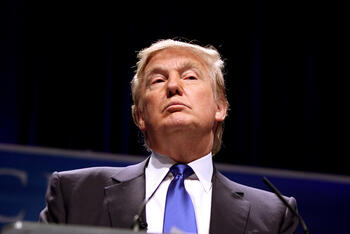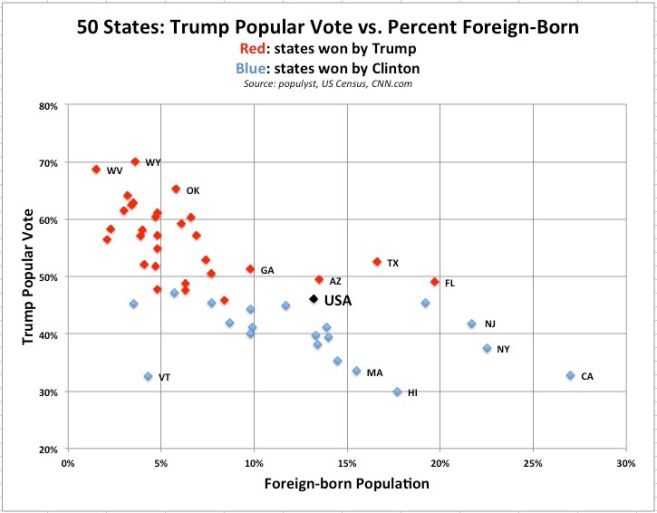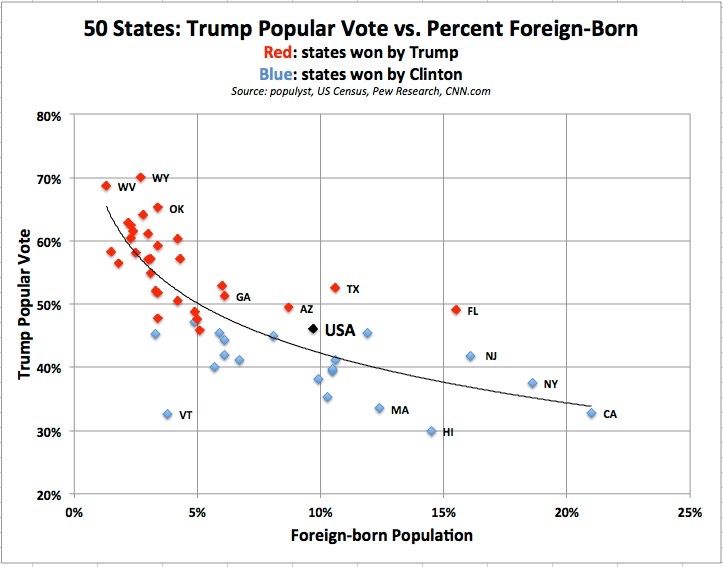
Trump did best in the states with the lowest percentages of foreign-born residents.
“I love the poorly-educated”, gushed Donald Trump after winning the Nevada primary in February. But in the end, what happened in the primary, stayed in the primary. Come November, Trump lost the state to Hillary Clinton, a turn that is explained by the fact that there is a higher percentage of foreign-born residents in Nevada than in any state won by Trump, save Florida.
In fact, Trump won the general election because he carried almost all of the states where there are few foreign-born residents. His anti-immigration message resonated most in the parts of the country that have the fewest immigrants. Of course, he also won immigrant-heavy Arizona, Florida and Texas, but mainly by prevailing in rural counties. He lost in the counties that include the major urban centers of Miami, Orlando, Tampa, Dallas, Houston, Austin and San Antonio. He did win in Maricopa county where Phoenix is located but perhaps not in Phoenix itself. (Maricopa county encompasses a lot more than Phoenix as it is larger by itself than the entire state of New Jersey, and larger than Connecticut and Delaware put together.)
If the size of the Trump vote can be used as a proxy for a state’s sentiment towards immigration and concern about terrorism, and it probably can, then it seems that the people who are most worried about immigration and terrorism are those who are the least exposed to it and the least at risk from it. This is counter-intuitive from the point of view of probability: why worry about a low probability event? But it could make sense from the point of view of fear: many people can be prone to fear and to misunderstand what they do not know well. Their opinions of others are formed mainly by what they see or read in the media, rather than by their own first-hand experiences.
Where Trump Won
In the United States overall, there were in 2015 as many as 42 million people who were born in another country, or 13.2% of the US population. But as shown in the chart, every state won by Trump last November, except for Arizona, Texas and Florida, has a smaller percentage of foreign-born than the national average. In fact, the lower the percentage of foreign-born in a given state, the better Trump has done in that state.
In Wyoming and West Virginia (3.6% and 1.5% foreign-born), he carried approximately 70% of the popular vote. But in Georgia (9.8% foreign-born), he carried about 50%. This difference in the vote cannot be totally attributed to the fact that a majority of the foreign-born probably went for Clinton, given that the difference between 70% and 50% is far higher than the difference between 9.8% and 3.6% and that the latter variable includes non-voters such as children and undocumented immigrants.

Meanwhile California, New York, New Jersey, Nevada, Hawaii and Massachusetts all have a higher percentage of foreign-born than the national average and they all voted for Hillary Clinton by wide margins. With Illinois, the District of Columbia, Washington state and a few others, these are the states with the big urban centers that saw the largest protests against the recent executive order banning entry from seven Muslim countries.
In the above chart, the percent of foreign-born (provided by the US Census) includes unauthorized migrants. Pew Hispanic Research estimated their numbers in every state as of 2014. If we strip the unauthorized figure from the foreign-born figure, we end up with an even better correlation. The resulting chart below reinforces the notion that Trump did well in inverse proportion to the foreign-born presence in any state.
Texas and Florida are moderate outliers in the sense that Trump did better than one would have expected from the regression. But conversely, he did far worse in the New England states, in particular Vermont, New Hampshire and Maine all of which have fewer than 5% foreign-born in their populations. Vermont is a big outlier, ostensibly because of the number of former New Yorkers living in the state, or the Bernie Sanders factor. Its total population is also very small at around 630,000.
(click and zoom in to enlarge the table)

With his current policies, the President is not courting any immigrant-heavy states and his solid base elsewhere allows him to ignore the protests. People who live in the rural South or Midwest may feel just as strongly in favor of the visa ban or of other Trump initiatives but their low-density living makes it harder for them to make their numbers visible through outdoor protests. The same is true of the lower density regions of Arizona, Florida and Texas where support for Trump was rock solid.
Terror Calculus
It is also worth noting that the Trump states (red in the chart) have not been the targets of terrorist activities or threats to the same extent as New York or Washington DC. So here again, the people more often targeted by terrorism seem less worried about newcomers and Muslims than people who live in a small town or rural setting where the odds of terror attacks are close to nil. Terrorists want to inflict as much damage and as many casualties as possible, a more attainable goal in dense urban centers. Even if they targeted smaller localities, the odds that it would be one’s own small town out of thousands of others are probably no greater than the odds of a mass shooting by a citizen born and raised in the United States.
Meanwhile, there is only one New York City and only a few cities of the size of Chicago or Washington DC. Even in these cities, the odds of being a victim of terrorism are very small. An attack may well occur but the likelihood that it will be at the exact time T and place P where a resident R may find himself, out of hundreds of millions of other possible daily T-P-R combinations, is indeed minimal. Of course, a scenario involving a WMD attack throws off this tragic and otherwise reassuring calculus. But then this speaks more to the need for detection and prevention of WMDs, rather than to the extreme vetting of individuals originating from certain countries.
So to sum up, people who have few if any foreign neighbors appear to be more worried about foreigners and terrorism than people who have many foreign neighbors. And from their sparsely populated townships, they could now effect restrictive policies not only for their own localities, but even for the large cities that they rarely visit. This is not so unusual. Historically, decisions made at the center have not always complied with local preferences. However, it should be added that historically, it was more often the preferences of the big cities that were imposed on the great plains.
President Trump says he loves the poorly-educated but he also relies on the support of voters who are less exposed to immigrants. Which then begs the following question: how deep is these voters’ sentiment towards the foreign-born in places where they are scarce, and for how long can the President tap it to maintain his popularity? A lot hinges on the answer.
Sami Karam is the founder and editor of populyst.net and the creator of the populyst index™. populyst is about innovation, demography and society. Before populyst, he was the founder and manager of the Seven Global funds and a fund manager at leading asset managers in Boston and New York. In addition to a finance MBA from the Wharton School, he holds a Master's in Civil Engineering from Cornell and a Bachelor of Architecture from UT Austin.
Photo: Gage Skidmore, CC License














Lies, damn lies, and correlations.
Trump won the general election because he carried almost all of the states where there are few foreign-born residents.
Those states also have a number of people who fled from from the brave new metro areas that were Clinton’s sole support. By a curious coincidence, those metro areas also contain a higher percentage of childless white slackers. Also white people in non-productive businesses (and unions) that depend on corruption and bureaucracy, and for generations have been buying privileges from Democrats with their votes and donations. Also non-white voting blocs that have been selling their votes to Democrats for just as long.
Many Democrats don’t seem to realize this, but in today’s media-dominated society, the people in flyover country actually have some idea of what things are like in the brave new metros. Some of them have even traveled there themselves, and know people who have lived there. Their ideas about the cites are often not very accurate in detail or perspective, but it takes only a few prominent and simple facts to give the lie to the propaganda that suffices for gullible or venal urban voters.
...their low-density living makes it harder for them to make their numbers visible through outdoor protests.
Actually they get around pretty well in all those evil automobiles of theirs. (Look at football attendance in those areas. I grant you that’s mostly the idiot fringe, but it does disprove your point. Smart people can drive too.) However, they can’t miss work. Or be long away from their families. And they have better things to do with their time off.
It is also worth noting that the Trump states (red in the chart) have not been the targets of terrorist activities or threats to the same extent as New York or Washington DC.
“To the same extent” is a giveaway qualification. How many such incidents does it take to get the point across? In any case, it’s the people from Trump country who get shipped off to fight the wars that terrorism provokes. They’ve seen the immigrants at home. The Trump vote that stomped the Republican mainstream in the primaries, and gave him a sweeping victory in the Electoral College, was to a very important extent an anti-war vote.
Meanwhile, there is only one New York City and only a few cities of the size of Chicago or Washington DC. Even in these cities, the odds of being a victim of terrorism are very small.
I am restraining myself firmly here. I’m from New York, and remember 9/11 very well. I did not happen to be one of the victims, and am fortunate not to have lost anyone I know, though there were some close calls. But my neighborhood was full of posters put up by people with photographs of missing family, asking for any information about them. It took a while for it to sink in that there were no wounded among those who didn’t get out of the towers, no-one in hospitals waiting to be identified. There weren’t even any bodies--just films of blood and flesh on the rubble. So in addition to the 3,000 dead, there were all their relatives and friends. Plus, as you may have forgotten, Manhattan is a very densely inhabited place. especially during working hours. So hundreds of thousands (including me) were stuck downtown all day, and very conscious that they were within a mile of one of the most horrible acts of violence in the U.S. since the Civil War. Even if you weren’t in Manhattan, if you lived downwind from the towers, your neighborhood was littered with paper that blew into the air when they collapsed, and the column of smoke overhead lasted for days. (It caused as lot of illness.) You also heard sirens non-stop for days, and for the first time in memory, there were no planes in the air except military planes. So hundreds of thousands at least--more likely millions--were traumatized, shocked, or horrified by that one act of terrorism. Most New Yorkers being from somewhere else, that number includes many people elsewhere in the country. It takes someone singularly vicious or bubbleheaded to be unaffected by the horror. Such people, however, do tend to concentrate in major cities, and especially in New York.
In this connection, I will repeat something from my first paragraph: The metros that went for Clinton hold a lot of “white people in non-productive businesses ... that depend on corruption and bureaucracy, and for generations have been buying privileges from Democrats with their votes and donations.” Those businesses include your own: finance and urban planning. That, I submit, says all that needs to be said.
How deep is these voters’ sentiment towards the foreign-born in places where they are scarce, and for how long can the President tap it to maintain his popularity?
Very, very deep. That sentiment will long outlast Trump, no matter what Trump does or how badly he fails. They knew exactly what Trump was when they voted for him. He’s pretty obvious, and he had two years to get his personality across to the entire nation. The people who voted for Trump (except a few half-wits who were the only ones the media covered) don’t identify with Trump, or with all of his policies. They just correctly identified him, in the primaries and the election, as the only chance for change. They wanted that change badly enough to vote for Trump. They still want change, and now they know they can get it. Their sentiments will have a large effect in the mid-term elections--again, no matter what Trump does.